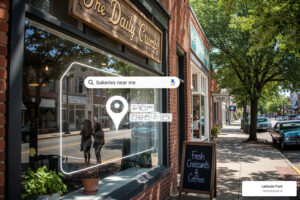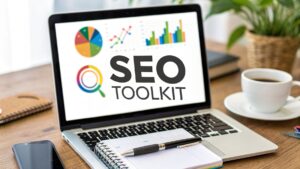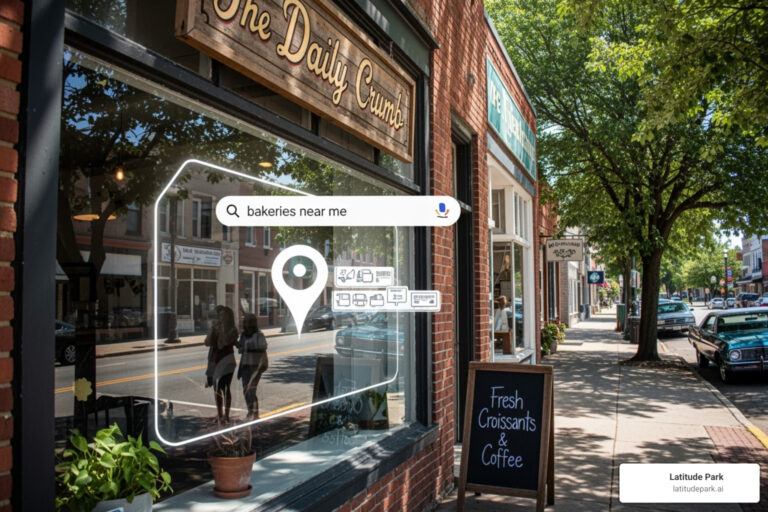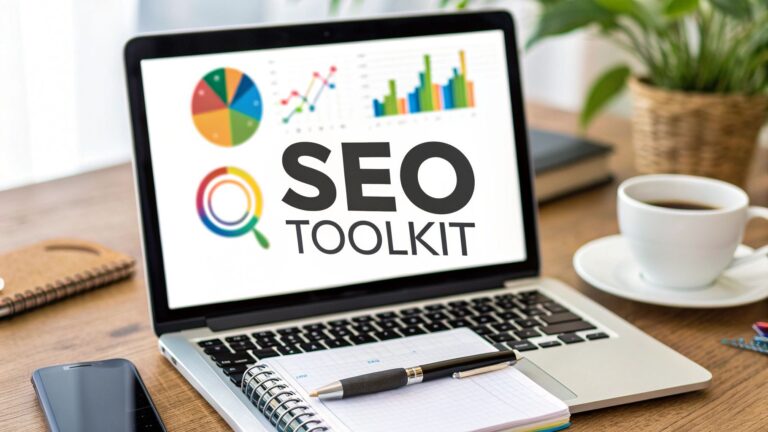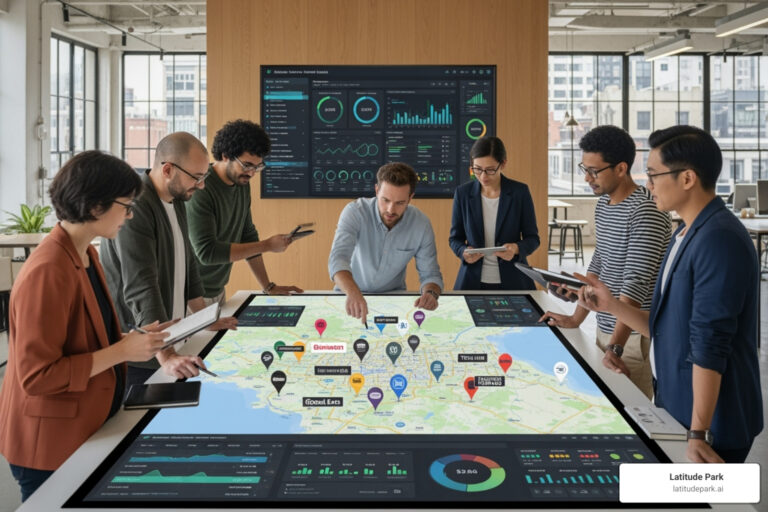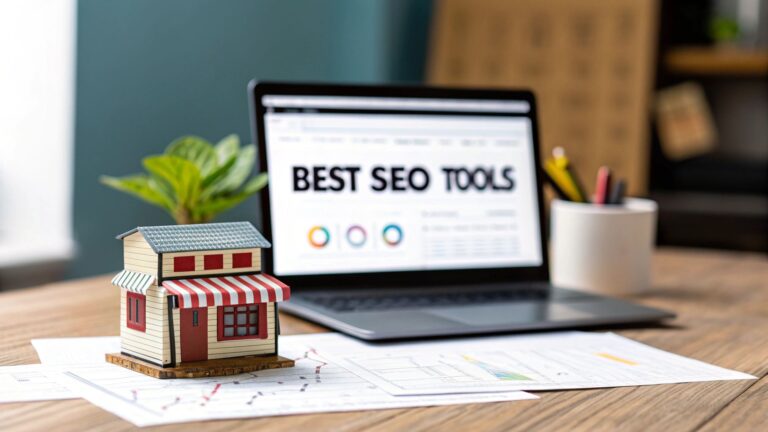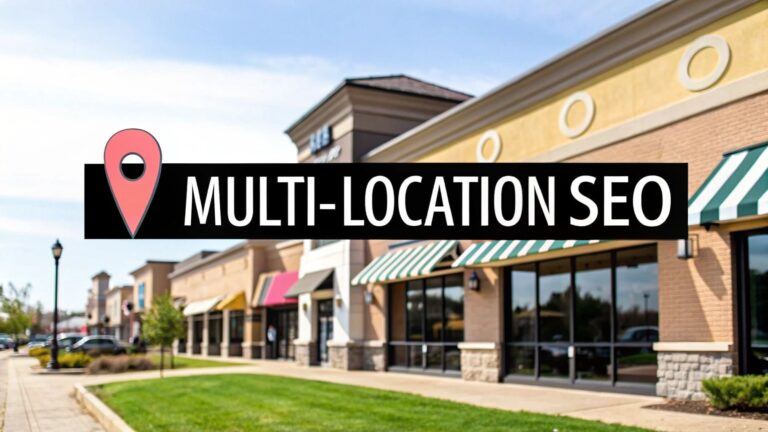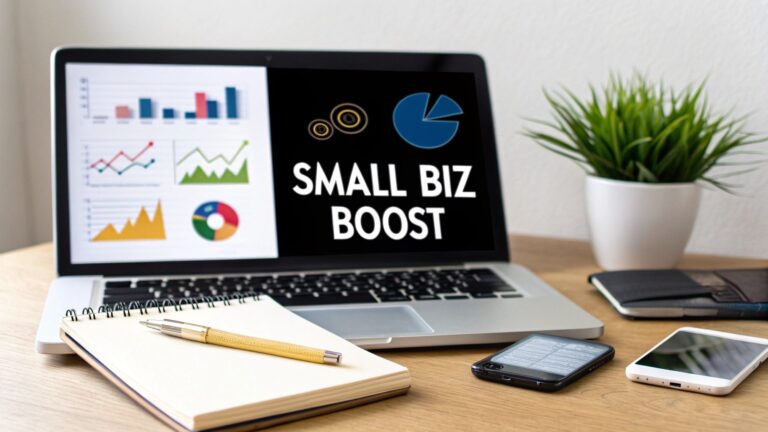Why Google Ads Are Essential for Local Businesses
Local business Google Ads are powerful advertising tools that help businesses connect with customers in their specific geographic area. With over half of Google searches having local intent, being visible at the moment a customer searches “plumber near me” or “best pizza in Brooklyn” is critical. When local customers search, they are ready to take action.
Google offers two main platforms for this: Traditional Google Ads (pay-per-click campaigns with full customization) and Local Services Ads (LSAs), which are pay-per-lead ads for service businesses that build trust with verification badges. Both platforms place your business at the top of local search results, targeting customers actively looking for your services.
I’m Rusty Rich, President of Latitude Park, a digital advertising agency. Since 2009, I’ve helped businesses master local business Google Ads to drive measurable growth. This guide provides five simple steps to launch successful campaigns and connect with ready-to-buy local customers.
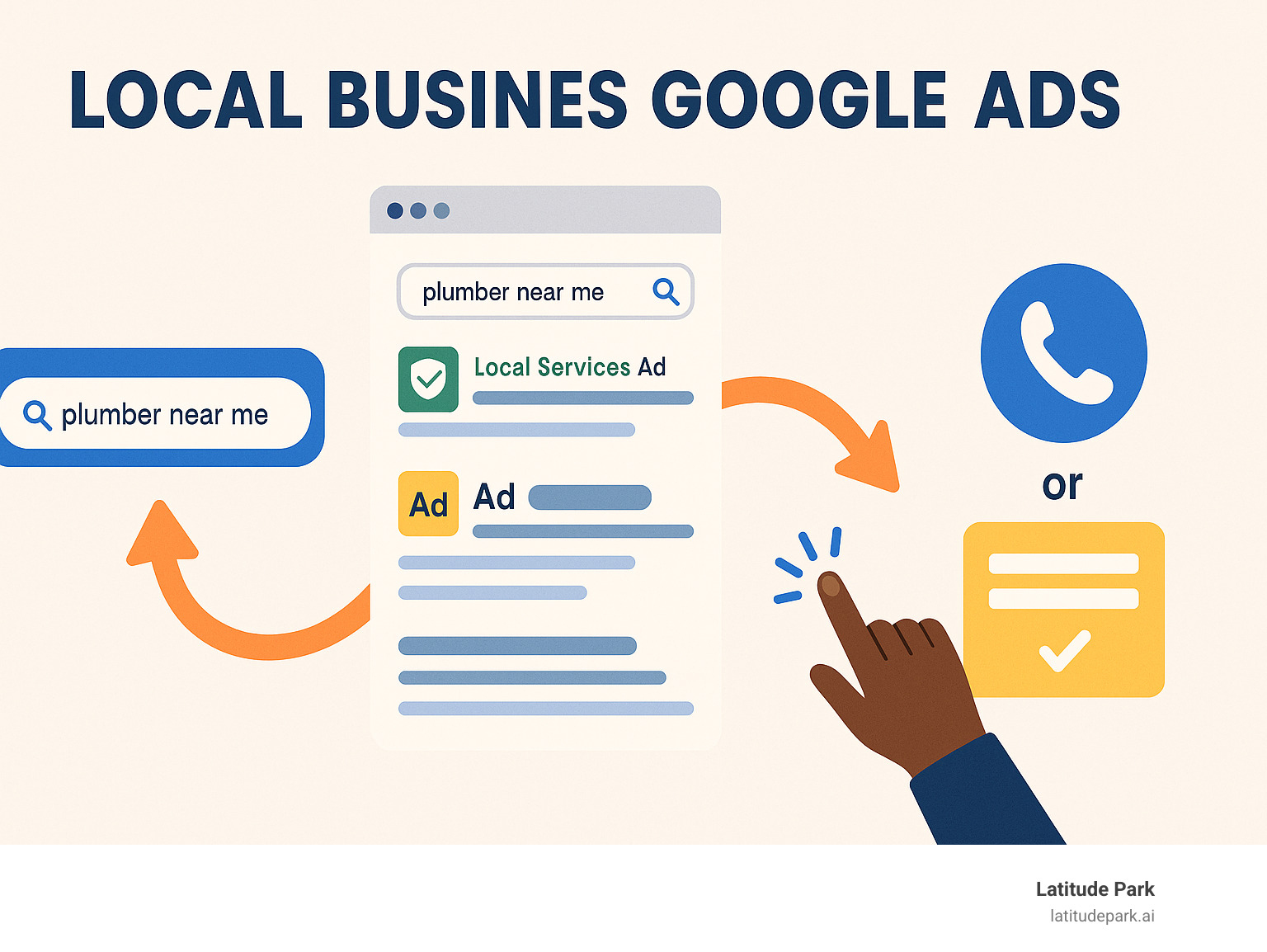
Easy local business google ads glossary:
- best google ad extensions for local business clients
- best google ads retargeting techniques for my local business clients
Step 1: Choose the Right Ad Type for Your Business
This first step is crucial, as Google offers different ad platforms for specific business needs. Understanding the difference between traditional Google Ads and Local Services Ads will set your campaign up for success.
Traditional Google Ads: Maximum Control and Reach
Traditional Google Ads offer incredible versatility and control. Built on a pay-per-click (PPC) model, you only pay when someone clicks your ad. The platform operates on a keyword bidding system through Google’s ad auction. When someone searches for a term you’ve bid on, like “emergency plumber,” your ad can appear.
Its flexibility allows you to create Search ads in Google’s results, Display ads on websites, or Video ads on YouTube. This variety helps you reach customers at different stages of their journey.
Traditional Google Ads work well for e-commerce businesses driving website traffic and for brand awareness campaigns. The targeting options are highly detailed, allowing you to focus on specific locations, demographics, interests, and even past website visitors.
For local business Google Ads, you can add features like call extensions for direct calls, location extensions to show your address, and review extensions to display your star ratings. You have full control to adjust budgets, test ad messages, and target customers with precision.
For a deeper dive, check out our guide: Everything You Need to Know About Paid Google Ads: The Marketer’s Guide.
Local Services Ads (LSAs): Trust and High-Quality Leads
Local Services Ads are designed for service-based businesses and operate on a pay-per-lead (PPL) model. You only pay when a potential customer contacts you through a call or message from the ad.
LSAs appear at the very top of search results, even above traditional ads. This prime placement comes with a powerful trust signal: either a Google Guaranteed badge for home services or a Google Screened badge for professional services. These badges show that Google has completed background and license checks, giving customers confidence in your business.
When someone clicks your LSA, they can call or message you directly, streamlining the connection. LSAs are ideal for plumbers, electricians, HVAC technicians, lawyers, real estate agents, dentists, and other service providers. Google continues to expand the list of eligible industries.
To see if your business qualifies, you can check your business eligibility directly with Google.
Google Ads vs. Local Services Ads: A Quick Comparison
| Feature | Traditional Google Ads | Local Services Ads |
|---|---|---|
| Cost Model | Pay-per-click (PPC) | Pay-per-lead (PPL) |
| Primary Goal | Drive clicks, website traffic, brand awareness | Generate direct leads through calls and messages |
| Ad Placement | Search results, websites, YouTube | Top of Google Search for local services |
| Targeting Control | Highly customizable targeting options | Primarily location-based targeting |
| Key Feature | Complete ad customization and broad reach | Google Guaranteed/Screened trust badges |
Many businesses use both platforms together to maximize visibility and capture customers at different points in their search journey.
Step 2: Set Up Your Foundational Accounts
Before launching ads, you need the right accounts in place. These platforms are the bedrock of your local advertising efforts, providing Google with the essential information to run your campaigns effectively.
Create Your Google Ads Account
Setting up a Google Ads account is your first step into the advertising ecosystem. The process is straightforward: you’ll enter your business information, website domain, and payment method. Accuracy is key, as this information flows into your campaigns.
This account is your central command center for managing all traditional Google Ads campaigns, monitoring performance, and making adjustments. It’s the dashboard for your entire advertising operation.
Ready to begin? You can get started by visiting: Click here to get started with Google Ads.
Optimize Your Google Business Profile (GBP)
Your Google Business Profile is the secret weapon that makes your local business Google Ads more effective. It’s your free listing on Google Search and Maps that displays essential information about your business.
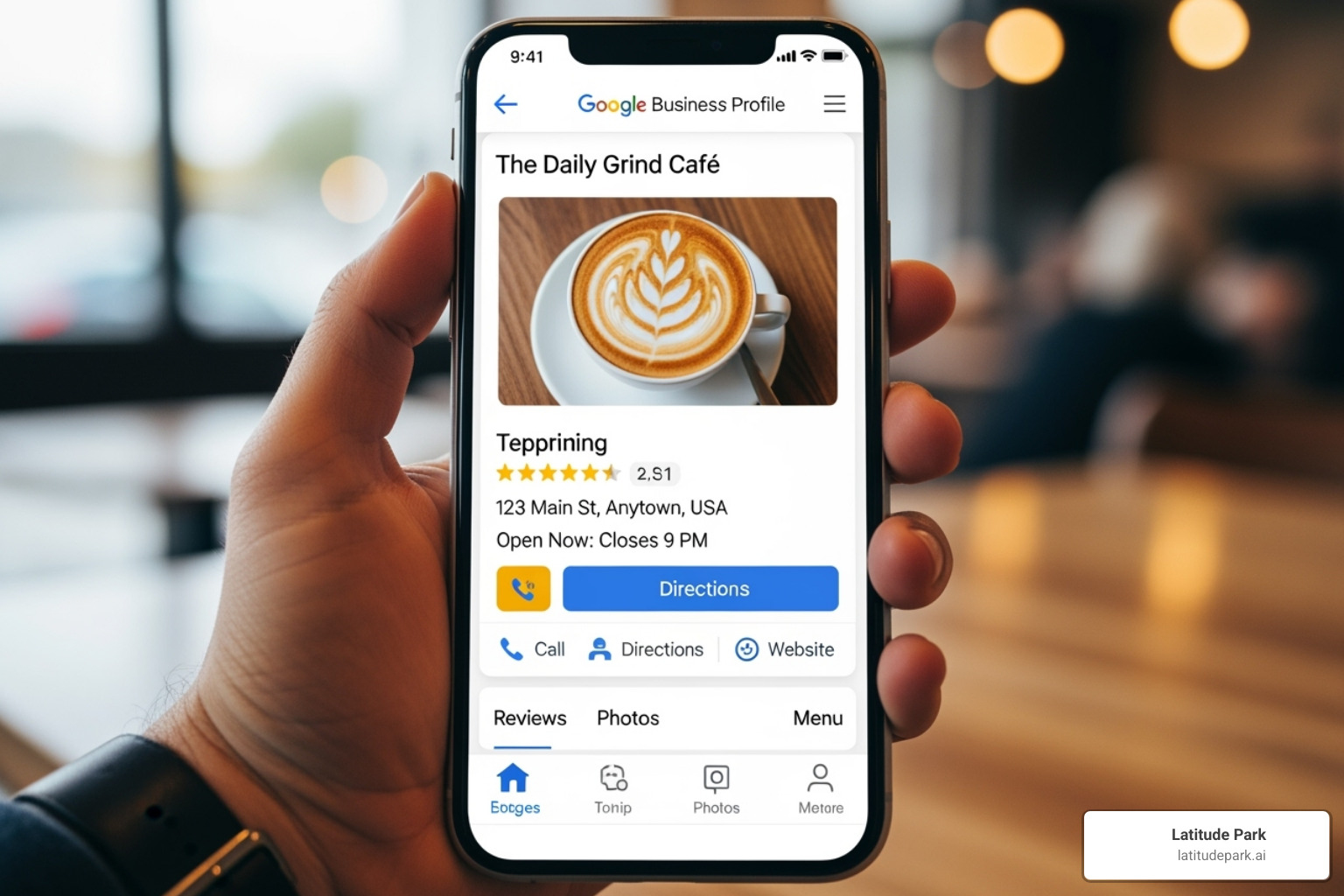
Crucially, your GBP connects to Google Maps and provides the location and review data that make your ads stand out. Google Ads pulls from your GBP to create powerful ad assets like call, location, and review extensions, making your ads bigger and more trustworthy.
Since 42% of local searchers click into map pack results, a well-optimized GBP is vital for visibility. It promotes your business hours, address, photos, and customer reviews, all of which drive better ad performance and are essential for running Local Services Ads.
To understand why a robust GBP is so crucial, read our guide: Why Local Business Listing is Essential.
Step 3: Build and Launch Your Local Business Google Ads Campaign
With your accounts ready, it’s time to build your first traditional Google Ads campaign. This is where you target the right people in the right place with the right message, creating a digital storefront for customers actively seeking your services.
Define Campaign Goals and Settings
First, define clear goals. Are you seeking phone calls, website traffic, or in-store visits? Your objectives will shape your campaign type and bidding strategy. Search campaigns are great for capturing active searchers, while Performance Max for store goals is designed for businesses with physical locations.
Your budget can start as low as £5 per day, making local business Google Ads accessible for any size business. Your bidding strategy determines how you compete in the ad auction; you might choose to maximize conversions for leads or maximize clicks for brand awareness.
For a complete walkthrough, our resource covers everything: Google Ads Local Business Guide.
Master Local Targeting and Ad Scheduling for your local business Google Ads
Precise targeting is crucial for local success. Geographic targeting lets you control where your ads appear by radius, specific postcodes, or entire cities. This ensures your budget isn’t wasted on clicks from outside your service area.

A critical setting is to choose “Presence: People in or regularly in your included locations” to avoid showing ads to people merely interested in your location. Use location exclusions to block areas you don’t serve.
Ad scheduling runs ads only when you’re available to respond, such as during business hours. A locksmith might run ads 24/7, while a dental practice may pause them overnight.
Write Compelling Ad Copy and Use Local Ad Assets
Responsive Search Ads (RSAs) are your best tool for ad copy. You provide multiple headlines and descriptions, and Google tests combinations to find the best performers. Use local keywords like “plumber in Brooklyn” to connect with nearby customers.
Highlight your unique selling propositions, such as “same-day service” or “free estimates,” to stand out. Google Ads assets (formerly extensions) improve your ads. Location assets show your address, and call assets allow users to phone you with one tap.
Sitelink assets link to specific pages like your menu or services, while image assets add visual appeal. Review assets build social proof by showcasing customer feedback. These assets improve click-through rates and give users more ways to engage.
For more strategies, see our tips: 9 Effective Digital Marketing Tips for Businesses.
Step 4: Getting Started with Local Services Ads (LSAs)
If you run a service-based business, LSAs are a powerful tool focused on verification and lead generation. It’s Google’s way of spotlighting trustworthy local providers.
Check Eligibility and Sign Up for Local Services Ads
First, confirm your business qualifies. Google covers a wide range of categories, including home services (plumbing, HVAC), business services (legal, accounting), health services, care services, and more. They are ideal for connecting with customers who are ready to hire someone immediately.
The sign-up process is straightforward. You’ll provide your business details, operating hours, service area, and the specific services you offer. This information helps Google match you with the right customers.
Ready to get started? You can begin the sign-up process here: Get Started with Local Services Ads.
Complete the Verification Process for Your Badge
This verification process is what makes LSAs so powerful for building customer trust. It’s like earning a stamp of approval from Google.

The Google Guaranteed badge is for home services businesses. It involves background checks and verification of licenses and insurance. If a customer isn’t satisfied with work booked through an LSA, Google may reimburse them up to a certain limit.
The Google Screened badge is for professional services like lawyers and financial planners, involving similarly rigorous background and license checks. These badges appear next to your ad, building instant credibility and eliminating much of the hesitation that comes with hiring a new service provider.
Set Your Budget and Service Area for your local business Google Ads
One of the best features of LSAs is the pay-per-lead structure. You only pay when someone contacts you through your ad.
Setting your weekly budget is a strategic decision based on how many new leads you can handle. You can specify exactly which cities or postcodes you serve, ensuring every lead is within your coverage area.
A key feature is the ability to pause your ads instantly when you’re too busy. This gives you complete control over your lead flow, preventing you from becoming overwhelmed and allowing you to provide excellent service to every customer.
Step 5: Track, Analyze, and Optimize for Success
Launching your ads is just the beginning. Continuous monitoring and optimization are what separate a good campaign from a great one, ensuring you get the best return on your investment.
Monitoring Your Google Ads Performance
Tracking performance is essential. Google provides detailed data to help you make smart decisions. Key metrics to watch include:
- Click-Through Rate (CTR): How compelling your ads are. A healthy CTR for local businesses is often 2-5%.
- Cost-Per-Click (CPC): How much you pay for each click.
- Conversion Rate: The percentage of clicks that turn into leads or sales.
- Cost-Per-Conversion: How much you spend to acquire a new customer. This is arguably the most important metric.
The Search Terms report shows you exactly what people typed into Google before clicking your ad. Use it to find new keyword opportunities and identify irrelevant searches to add to your negative keyword list. For example, a wedding photographer might add “free” and “jobs” as negative keywords.
Continuously A/B test your ad copy by trying different headlines and descriptions to see what resonates best. Even small improvements can lead to significant gains over time.
If your campaigns are underperforming, our guide on Google Ads Performance Dropping? can help you diagnose common issues.
Managing and Optimizing Local Services Ads
LSAs require active management to maximize results. The key factors for success are:
- Response Time: Google tracks how quickly you respond to leads and uses this as a major ranking factor. Faster responses lead to better ad placement.
- Marking Leads as Booked: When a lead becomes a customer, mark it as “booked” in your dashboard. This helps Google’s algorithm send you more similar, high-quality inquiries.
- Disputing Invalid Leads: You can dispute spam calls or inquiries for services you don’t offer. Google often provides credits for legitimate disputes.
- Customer Reviews: Reviews are the lifeblood of LSA success. The platform makes it easy to request reviews from customers through the LSA platform. More positive reviews improve your ad placement and conversion rates.
The LSA mobile app is a handy tool for managing leads, communicating with customers, and pausing your ads on the go. By staying responsive and managing your reputation, you can build a sustainable lead generation system.
Frequently Asked Questions about Local Google Ads
Here are answers to the most common questions business owners have about local business Google Ads.
How much do local Google Ads cost?
This depends on the ad type and your industry. Traditional Google Ads use a pay-per-click (PPC) model where you set your budget and bid on keywords. The cost-per-click can range from a few dollars to over fifty in competitive fields like law. You have full control over your daily spending.
Local Services Ads use a pay-per-lead (PPL) model. You pay a fixed cost for each valid lead (a call or message from a potential customer). You set a weekly budget based on how many leads you want, making it highly predictable.
Do I need a website to run local Google Ads?
It depends. For Local Services Ads, a website is not required. Customers contact you directly through the ad, so your LSA profile acts as a mini-website. This makes LSAs great for businesses just starting their online presence.
For traditional Google Ads, a website is highly recommended. While you can run call-only campaigns, sending users to a quality landing page where they can learn more about your business almost always leads to better results and builds customer trust.
How do local ads complement my SEO efforts?
They work together perfectly. Ads provide immediate visibility at the top of search results while your long-term SEO efforts build momentum. The data from your Google Ads campaigns, such as high-performing keywords, is a goldmine for your SEO strategy, telling you exactly what terms to optimize your website for.
Local Services Ads provide an extra SEO boost through customer reviews. Since reviews are a critical ranking factor for local SEO, every positive review you earn through LSAs helps strengthen your organic visibility in both search results and the Google Map Pack. This creates a cycle where paid ads improve your free organic presence.
Learn more about maximizing your local search presence in our guide: Local SEO: Optimizing Your Website for Local Search Results.
Conclusion: Take Your Local Business to the Next Level
You now have a roadmap for launching successful local business Google Ads campaigns. These five steps are the process we use to connect businesses with ready-to-buy customers in their local markets.
Google’s platforms meet customers exactly where they are: actively searching for your services. By choosing the right ad type, setting up your accounts correctly, and continuously optimizing, you can turn Google into a reliable growth engine.
Success isn’t about perfection from day one; it’s about starting smart, measuring what matters, and improving over time. Whether you choose the control of traditional Google Ads or the trust of Local Services Ads, both platforms reward engaged and responsive businesses.
While Google excels at capturing search intent, a complete digital strategy often includes other platforms. For businesses with complex structures like franchises, custom strategies on platforms like Meta (Facebook) can be incredibly effective for creating local connections—a specialty of our team at Latitude Park. We understand the unique challenges of multi-location businesses and build campaigns that work both locally and at scale.
Ready to master digital advertising? Explore our expert Google & YouTube Ads management services and let us help you grow.

